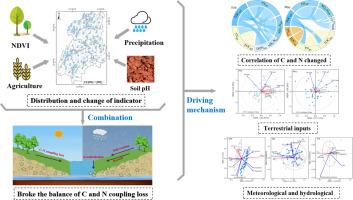季节性降雨变化破坏了亚热带酸化流域碳氮耦合损失平衡
IF 5.7
1区 农林科学
Q1 AGRONOMY
引用次数: 0
摘要
碳氮耦合损失是受生物地球化学相互作用影响的重要生态过程,而亚热带流域碳氮耦合平衡经常因显著的季节变化而被破坏。研究了中国南方一个代表性的亚热带酸性流域陆地-河流-河口连续体碳氮耦合损失的驱动机制。通过多季节采样、野外研究和分布式水文模型,分析了地表水、床层沉积物和垂直沉积物中碳氮浓度的时空格局。本研究揭示了旱季碳氮损失之间存在较强的耦合效应(R = 0.702, P < 0.01)。相反,雨季降雨等季节性因素破坏了这种耦合平衡。表层水总有机碳浓度显著升高(平均为2.26 mg/L),而铵态氮的比例由于硝化和稀释作用的增强而降低了50%。空间分析强调了污染物的下游积累,主要是由弥漫性农业源和沉积物沉积驱动的。冗余分析表明,降水pH值、土壤pH值和植被指数(NDVI)是这些过程的关键驱动因素。这项研究强调了碳氮耦合对季节水文变化和人为压力的脆弱性。探索流域碳氮耦合损失的季节特征及其驱动机制,可以进一步阐明流域弥漫性污染的影响因素,为制定有效的流域管理策略提供有价值的见解。本文章由计算机程序翻译,如有差异,请以英文原文为准。

Seasonal rainfall variation disrupted the balance of carbon and nitrogen coupling loss in subtropical acidified watershed
Carbon and nitrogen coupling loss is a critical ecological process influenced by biogeochemical interactions, while the balance is frequently disrupted by significant seasonal variability in subtropical watersheds. This study investigated the mechanisms driving carbon‒nitrogen coupled loss across the land-river-estuary continuum in a representative subtropical acidic watershed in southern China. Through multi-season sampling, field research, and a distributed hydrological model, we analyzed spatiotemporal patterns of carbon and nitrogen concentrations in surface water, bed sediments, and vertical sediments. This study revealed a strong coupling effect between carbon and nitrogen loss during the dry season (R = 0.702, P < 0.01). In contrast, seasonal factors such as rainfall in the wet season disrupted this coupling balance. The total organic carbon concentration in surface water increased significantly (with an average value of 2.26 mg/L), whereas the proportion of ammonium nitrogen decreased by 50% due to enhanced nitrification and dilution effects. Spatial analysis highlighted the downstream accumulation of pollutants, which were driven primarily by diffuse agricultural sources and sediment deposition. Redundancy analysis identified precipitation pH, soil pH, and the vegetation index (NDVI) as key drivers of these processes. This study underscores the vulnerability of carbon-nitrogen coupling to seasonal hydrological shifts and anthropogenic pressures. Exploring the seasonal characteristics and driving mechanisms of carbon and nitrogen coupling loss can further elucidate the factors influencing watershed diffuse pollution and provide valuable insights for formulating effective watershed management strategies.
求助全文
通过发布文献求助,成功后即可免费获取论文全文。
去求助
来源期刊
CiteScore
10.30
自引率
9.70%
发文量
415
审稿时长
69 days
期刊介绍:
Agricultural and Forest Meteorology is an international journal for the publication of original articles and reviews on the inter-relationship between meteorology, agriculture, forestry, and natural ecosystems. Emphasis is on basic and applied scientific research relevant to practical problems in the field of plant and soil sciences, ecology and biogeochemistry as affected by weather as well as climate variability and change. Theoretical models should be tested against experimental data. Articles must appeal to an international audience. Special issues devoted to single topics are also published.
Typical topics include canopy micrometeorology (e.g. canopy radiation transfer, turbulence near the ground, evapotranspiration, energy balance, fluxes of trace gases), micrometeorological instrumentation (e.g., sensors for trace gases, flux measurement instruments, radiation measurement techniques), aerobiology (e.g. the dispersion of pollen, spores, insects and pesticides), biometeorology (e.g. the effect of weather and climate on plant distribution, crop yield, water-use efficiency, and plant phenology), forest-fire/weather interactions, and feedbacks from vegetation to weather and the climate system.

 求助内容:
求助内容: 应助结果提醒方式:
应助结果提醒方式:


